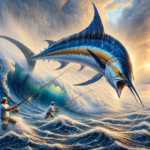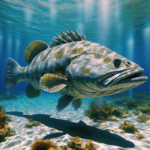Surf Fishing in California’s Coastal Waters

Introduction
Did you know that California boasts over 800 miles of coastline, offering some of the best surf fishing opportunities in the United States? Whether you’re a seasoned angler or a novice looking to dip your toes into the world of surf fishing, California’s coastal waters provide a diverse and exciting fishing experience.
This article will cover everything you need to know about surf fishing in California, from the best fishing techniques and species information to top fishing spots and seasonal considerations. We’ll also delve into essential gear recommendations, safety tips, and conservation practices to ensure a successful and responsible fishing trip.
Understanding the intricacies of surf fishing in California is crucial for maximizing your catch and enjoying a fulfilling experience. Whether you’re aiming to find the best fishing spots, master specific techniques, or prepare for an upcoming event, this guide has you covered.
Background/Context
Historical or Cultural Significance
Surf fishing has deep roots in California’s history and culture. Indigenous peoples along the coast have been fishing these waters for thousands of years, relying on the ocean’s bounty for sustenance. In more recent history, surf fishing gained popularity in the mid-20th century as recreational fishing became a beloved pastime for many Californians.
Geographical Overview
California’s coastline is incredibly diverse, ranging from the rugged cliffs of Big Sur to the sandy beaches of Southern California. The state’s coastal waters are influenced by the cold California Current, which brings nutrient-rich waters that support a wide variety of marine life. The climate varies from the cool, foggy conditions of the northern coast to the warm, sunny beaches of the south, providing a range of fishing environments.
Key Points/Details
Fishing Techniques
Technique Overview
Surf fishing involves casting your line from the shore into the surf zone, where waves break and create a dynamic environment rich in marine life. Common techniques include:
- Bottom Fishing: Using weighted rigs to keep bait near the ocean floor.
- Float Fishing: Employing a float to keep bait suspended in the water column.
- Lure Fishing: Casting and retrieving artificial lures to attract predatory fish.
When and Where to Use
Each technique has its ideal conditions:
- Bottom Fishing: Best for targeting species like surfperch and halibut, especially in areas with sandy or rocky bottoms.
- Float Fishing: Effective in calmer waters or when targeting fish that feed higher in the water column.
- Lure Fishing: Ideal for active predatory fish like striped bass and can be used in various surf conditions.
Recommended Gear
For surf fishing, you’ll need:
- Rods: Medium to heavy action surf rods, typically 9-12 feet long.
- Reels: Spinning or conventional reels with a high line capacity.
- Lines: Braided or monofilament lines, 15-30 lb test.
- Bait/Lures: Sand crabs, bloodworms, and artificial lures like spoons and soft plastics.
Species Information
Species Overview
California’s coastal waters are home to a variety of fish species, including:
- Surfperch: Commonly found in the surf zone, especially during the spring and summer months.
- Halibut: Prefers sandy bottoms and can be caught year-round, with peak seasons in spring and summer.
- Striped Bass: Migratory fish that can be found along the coast, particularly in Northern California.
- Leopard Shark: Often found in shallow waters and estuaries, providing an exciting challenge for anglers.
Best Practices
To successfully catch these species, consider the following tips:
- Surfperch: Use small hooks and light tackle with sand crabs or bloodworms as bait.
- Halibut: Employ live bait like anchovies or artificial lures that mimic small fish.
- Striped Bass: Cast lures like swimbaits or topwater plugs during dawn or dusk when they are most active.
- Leopard Shark: Use cut bait like mackerel or squid and fish near estuaries or shallow bays.
Location Information
Top Fishing Spots
Some of the best surf fishing spots in California include:
- Santa Monica Pier: Offers easy access and a variety of fish species.
- Huntington Beach: Known for its consistent surf and abundant surfperch.
- Monterey Bay: Provides opportunities to catch halibut and striped bass.
- Point Reyes National Seashore: A prime location for surfperch and occasional leopard sharks.
Regulations and Licenses
Before you start fishing, make sure to:
- Obtain a valid California fishing license, available online or at local retailers.
- Check local regulations for specific catch limits, size restrictions, and seasonal closures.
- Be aware of protected areas where fishing may be prohibited.
Seasonal Considerations
Seasonal Variations
Fishing conditions in California’s coastal waters change throughout the year:
- Spring: Surfperch and halibut become more active as water temperatures rise.
- Summer: Peak season for surfperch, with increased activity from other species like striped bass.
- Fall: Good time for halibut and striped bass as they prepare for winter.
- Winter: Fishing can be slower, but species like surfperch are still available.
Best Times to Fish
The optimal times for surf fishing are:
- Early Morning: Fish are more active during dawn.
- Late Afternoon: Dusk is another prime time for feeding activity.
- Tidal Changes: Fish tend to be more active during incoming and outgoing tides.
Events and Tournaments
Event Overview
California hosts several surf fishing events and tournaments, such as:
- Annual Surf Fishing Derby: Held in various locations along the coast, attracting anglers of all skill levels.
- Local Club Competitions: Many fishing clubs organize regular surf fishing contests.
Preparation Tips
To prepare for these events:
- Practice your casting and retrieval techniques.
- Ensure your gear is in top condition and suited for the target species.
- Research the event location and familiarize yourself with local conditions.
Tips and Best Practices
General Tips
For a successful surf fishing experience, consider these tips:
- Always check the weather and surf conditions before heading out.
- Use fresh bait to increase your chances of attracting fish.
- Be patient and persistent; surf fishing can require time and effort.
Avoid Common Mistakes
Common mistakes to avoid include:
- Overcasting: Fish are often closer to shore than you might think.
- Ignoring Tides: Tidal movements significantly impact fish activity.
- Using the Wrong Gear: Ensure your equipment matches the conditions and target species.
Advanced Techniques
For more experienced anglers, try these advanced techniques:
- Match the Hatch: Use bait and lures that mimic local prey species.
- Reading the Surf: Learn to identify productive fishing spots by observing wave patterns and water movement.
- Night Fishing: Some species are more active at night, providing unique opportunities.
Gear and Equipment Recommendations
Essential Gear
The essential gear for surf fishing includes:
- Surf rod and reel combo
- Braided or monofilament line
- Variety of hooks, weights, and rigs
- Bait (sand crabs, bloodworms) and lures (spoons, soft plastics)
- Tackle box and bait bucket
Optional Gear/Upgrades
Consider these additional items to enhance your experience:
- Waders for fishing in deeper water
- Fishing cart for transporting gear
- Polarized sunglasses to reduce glare and spot fish
- Fish finder for locating schools of fish
Where to Buy or Rent
You can purchase or rent gear from local shops such as:
- Fisherman’s Landing: Located in San Diego, offering a wide range of fishing gear.
- Melton Tackle: Based in Anaheim, specializing in surf fishing equipment.
- Online Retailers: Websites like Amazon and Bass Pro Shops offer extensive selections.
Safety and Conservation
Safety Tips
Ensure a safe fishing trip by following these tips:
- Always check the weather forecast and avoid fishing during storms or high surf conditions.
- Wear appropriate clothing and sun protection.
- Be aware of your surroundings and watch for wildlife hazards like jellyfish or stingrays.
- Fish with a buddy whenever possible for added safety.
Conservation Practices
Practice sustainable fishing by:
- Following catch and release guidelines for non-target species.
- Respecting local wildlife and habitats.
- Adhering to all fishing regulations and catch limits.
- Properly disposing of fishing line and other waste to protect marine life.
Planning Your Trip
Accommodations
Consider staying at these locations near popular fishing spots:
- Santa Monica Pier: The Georgian Hotel offers oceanfront views and easy access to the pier.
- Huntington Beach: The Waterfront Beach Resort provides comfortable accommodations close to the beach.
- Monterey Bay: The Monterey Plaza Hotel & Spa offers luxury stays with stunning bay views.
Travel Tips
For a smooth trip, keep these tips in mind:
- Plan your route and check for any road closures or traffic updates.
- Consider renting a vehicle if you need to transport bulky fishing gear.
- Arrive early to secure a good fishing spot, especially during peak seasons.
Additional Activities
If you have non-fishing companions or want to explore more, consider these activities:
- Santa Monica Pier: Enjoy the amusement park, aquarium, and local dining options.
- Huntington Beach: Visit the International Surfing Museum or take a surf lesson.
- Monterey Bay: Explore the Monterey Bay Aquarium or take a scenic drive along the coast.
Frequently Asked Questions (FAQs)
Do I need a fishing license to surf fish in California?
Yes, a valid California fishing license is required for surf fishing. You can purchase one online or at local retailers.
What is the best time of year for surf fishing in California?
Spring and summer are generally the best times for surf fishing, as many species are more active during these seasons.
What type of bait should I use for surf fishing?
Common baits include sand crabs, bloodworms, and cut bait like squid or mackerel. Artificial lures can also be effective.
Are there any specific regulations I should be aware of?
Yes, always check local regulations for catch limits, size restrictions, and seasonal closures. Some areas may also have protected zones where fishing is prohibited.
Conclusion
Surf fishing in California’s coastal waters offers a rewarding and exciting experience for anglers of all skill levels. By understanding the best techniques, species information, and top fishing spots, you can maximize your chances of a successful trip. Remember to follow safety guidelines and practice conservation to ensure the sustainability of this beloved pastime. So grab your gear, head to the beach, and enjoy the thrill of surf fishing in the Golden State!




